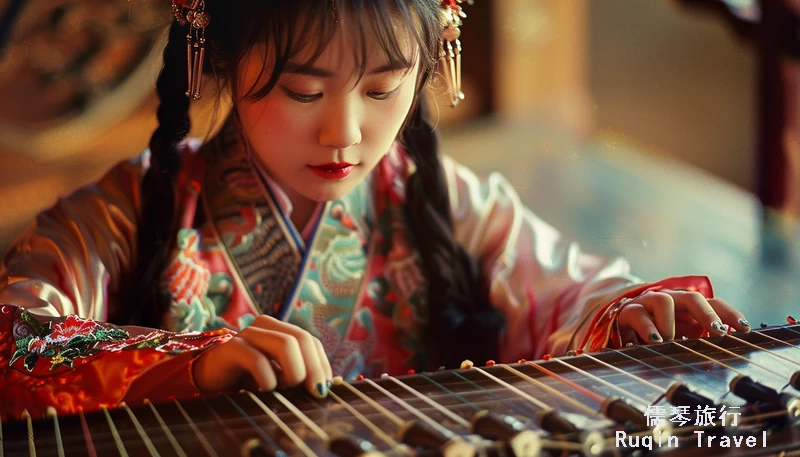Exploring traditional Chinese music instruments offers a captivating glimpse into China’s rich cultural heritage. These instruments, each with unique sounds and histories, continue to play an integral role in Chinese music.
This guide aims to introduce foreign tourists and enthusiasts to the fascinating world of traditional Chinese music instruments. It provides insights into their history, types, and cultural significance.
The Rich History of Chinese Music Instruments
The history of Chinese music instruments dates back thousands of years. Ancient artifacts, such as bone flutes, indicate that music was a significant part of Chinese culture even in prehistoric times.
Over centuries, various dynasties contributed to the development of Chinese music, leading to the creation of diverse instruments.
Initially, Chinese music was used in rituals and ceremonies. During the Zhou Dynasty (1046–256 BC), music was systematized, and the court established specific musical standards.
Confucius, the famous philosopher, emphasized music’s moral and ethical roles, influencing its development profoundly. Subsequently, during the Tang Dynasty (618–907 AD), Chinese music flourished, incorporating instruments and styles from other cultures.
Types of Traditional Chinese Music Instruments
Traditional Chinese music instruments are classified into three main categories: string, wind, and percussion instruments. Each category has unique characteristics and produces distinct sounds.
Chinese String Instruments
Chinese string instruments, known for their melodic and harmonious sounds, are integral to traditional Chinese music. Some of the most popular string instruments include the Guqin, Guzheng, Pipa, and Erhu.
The Guqin (古琴)
The Guqin, a seven-stringed zither, is one of China’s oldest instruments. It symbolizes Chinese culture and intellectualism. Playing the Guqin requires great skill and understanding of its intricate techniques. The instrument produces a serene and contemplative sound, ideal for solo performances.
The Guzheng(古筝)
Another popular zither, the Guzheng, has 18 to 21 strings. It is known for its broad range and expressive tones. Players use picks on their fingers to pluck the strings, creating vibrant and resonant music. The Guzheng is often featured in solo performances and ensembles.
The Pipa (琵琶)
The Pipa, a four-stringed lute, has a pear-shaped body and a history spanning over 2,000 years. It requires precise finger movements to produce its distinctive, lively sounds. The Pipa is a versatile instrument used in various music genres, from classical to folk music.
The Erhu (二胡)
The Erhu, often called the Chinese violin, is a two-stringed fiddle. It produces a hauntingly beautiful sound, capable of expressing deep emotions. Players use a bow to slide between the strings, creating a wide range of tones. The Erhu is a staple in both traditional and contemporary Chinese music.
Chinese Wind Instruments
Chinese wind instruments, characterized by their ethereal and airy sounds, are also essential in traditional music. Key wind instruments include the Dizi, Sheng, and Xiao.
The Dizi (笛子)
The Dizi, a bamboo flute, is one of the most recognizable Chinese wind instruments. It features a distinctive membrane that adds a bright, resonant quality to its sound. Players cover the holes along the flute to produce different notes. The Dizi is used in various musical settings, from solos to large orchestras.
The Sheng (笙)
The Sheng, a mouth-blown free reed instrument, has a history of over 3,000 years. It consists of multiple bamboo pipes, each producing a different note. The Sheng is unique because it can play chords and single notes simultaneously. Its harmonious sound is often compared to the Western harmonica.
The Xiao (箫)
The Xiao, an end-blown flute, produces a soft and mellow sound. Made from bamboo, it typically has six to eight finger holes. The Xiao is often associated with meditative and tranquil music, making it a favorite for solo performances.
Chinese Percussion Instruments
Chinese percussion instruments add rhythm and energy to music. These instruments include drums, gongs, and cymbals.
The Tanggu (堂鼓)
The Tanggu, a traditional Chinese drum, is used in various musical and ceremonial contexts. It has a powerful and resonant sound, played with sticks. The Tanggu often leads rhythms in Chinese ensembles and orchestras.
The Bo (钹)
The Bo, or Chinese cymbals, produce a bright and metallic sound. They come in various sizes and are typically used in pairs. The Bo adds dynamic accents to music, enhancing the overall performance.
The Luo (锣)
The Luo, or Chinese gong, is a large, flat metal disc struck with a mallet. It produces a deep, resonant sound that can vary in pitch. The Luo is commonly used in rituals, operas, and orchestral music to create dramatic effects.
Cultural Significance of Chinese Instruments
Traditional Chinese music instruments hold significant cultural value. They are not only tools for creating music but also symbols of Chinese heritage and philosophy.
Instruments in Rituals and Ceremonies
Many traditional Chinese instruments were initially used in rituals and ceremonies. For example, the Guqin was played during Confucian rites, symbolizing wisdom and moral integrity.
Similarly, drums and gongs were used in religious ceremonies to communicate with the divine.
Instruments in Folk Music
Instruments like the Erhu and Pipa play a crucial role in Chinese folk music. They are used to tell stories, express emotions, and celebrate events.
Folk music performances often involve ensembles, where each instrument adds a unique voice to the collective sound.
Instruments in Modern China
Today, traditional Chinese instruments continue to be celebrated and preserved. They are taught in music schools, featured in concerts, and used in contemporary music. Efforts to preserve these instruments ensure that their cultural significance endures for future generations.
Learning Traditional Chinese Music
For those interested in learning traditional Chinese music, numerous opportunities exist. From workshops to private lessons, aspiring musicians can explore these instruments and their techniques.
Workshops and Classes
Many cities in China offer workshops and classes focused on traditional Chinese music. These programs provide hands-on learning experiences, allowing students to practice under the guidance of skilled instructors. Workshops often cover instrument techniques, music theory, and performance skills.
Private Lessons
Private lessons offer personalized instruction for those seeking a more tailored learning experience. Students can choose their preferred instrument and work closely with a teacher to develop their skills. Private lessons provide flexibility and individualized attention, making them ideal for beginners and advanced learners.
Online Resources
In addition to in-person instruction, numerous online resources are available for learning traditional Chinese music. Websites, video tutorials, and online courses offer accessible and convenient ways to study these instruments from anywhere in the world.
Visiting China: Music and Cultural Experiences
Visiting China provides an excellent opportunity to experience traditional Chinese music firsthand. From attending performances to visiting museums, travelers can immerse themselves in the rich musical heritage of China.
Traditional Music Performances
Traditional Chinese music performances are a highlight for any visitor. Concerts, operas, and festivals feature talented musicians showcasing their skills on various instruments. Notable venues include the Shanghai Grand Theatre, the Beijing Concert Hall, and the Xi’an Tang Dynasty Music and Dance Show.
Music Instrument Museums
China boasts several museums dedicated to traditional music instruments. These museums offer insights into the history, construction, and cultural significance of various instruments. Notable museums include the China National Museum of Ethnology in Beijing and the Musical Instrument Museum in Shanghai.
Cultural Festivals
Attending cultural festivals in China allows visitors to experience traditional music in a festive atmosphere. Festivals like the Chinese New Year, Lantern Festival, and Dragon Boat Festival feature music performances as a central component. These events provide a vibrant and immersive cultural experience.
Music Stores and Workshops
For those interested in purchasing or learning more about traditional instruments, visiting music stores and workshops can be a rewarding experience. Stores like the Beijing Traditional Music Instrument Shop offer a wide range of instruments and accessories. Additionally, some workshops allow visitors to see the instrument-making process firsthand.
Famous Chinese Musicians
Learning about famous Chinese musicians can inspire and deepen appreciation for traditional music. These musicians have mastered their craft and significantly contributed to the preservation and promotion of Chinese music.
Liu Fang
Liu Fang is a world-renowned Pipa and Guzheng player. She has performed globally, showcasing the beauty and complexity of traditional Chinese music. Her dedication to her craft and ability to blend classical and contemporary styles have earned her international acclaim.
Wu Man
Wu Man is a celebrated Pipa virtuoso known for her innovative approach to traditional music. She has collaborated with various international artists and ensembles, bringing Chinese music to a global audience. Wu Man’s work has expanded the reach of traditional Chinese instruments.
Min Huifen
Min Huifen was a legendary Erhu player, known for her emotional and expressive performances. Her contributions to Chinese music have left a lasting legacy, inspiring new generations of musicians.
Zhao Jiazhen
Zhao Jiazhen is a respected Guqin player and scholar. She has dedicated her career to studying and promoting this ancient instrument. Zhao’s performances and research have helped preserve the cultural heritage of the Guqin.
How to Play Chinese Instruments
Playing traditional Chinese instruments requires dedication and practice. However, the process is rewarding and offers a deep connection to Chinese culture.
Choosing an Instrument
First, choose an instrument that resonates with you. Consider factors such as sound, technique, and personal interest. Research the instrument’s history and listen to performances to understand its unique characteristics.
Learning the Basics
Next, focus on learning the basics. Understand the instrument’s construction and how to produce sound. Practice fundamental techniques, such as finger placement for string instruments or breath control for wind instruments.
Practicing Regularly
Regular practice is essential for mastering any instrument. Set aside time each day to practice scales, exercises, and simple pieces. Gradually increase the difficulty of your practice material as your skills improve.
Seeking Guidance
Seeking guidance from a teacher or experienced musician can accelerate your learning process. Teachers can provide valuable feedback, correct mistakes, and offer tips for improvement. Additionally, joining a music group or ensemble can enhance your playing experience.
Traditional Chinese music instruments offer a fascinating glimpse into China’s cultural heritage. Whether you’re visiting China or simply interested in its music, exploring these instruments can be a deeply enriching experience. From the serene sounds of the Guqin to the vibrant tones of the Pipa, each instrument tells a unique story. By learning about and playing these instruments, you can connect with the rich traditions of Chinese music and culture. Check out China Cultural Insights for more information.
More China Cultural Insights
China is a country full of rich traditions, colorful festivals, and fascinating customs that have been passed down through generations. At China Cultural Insights by Ruqin China Travel, we want to help you experience the real China by understanding its culture.



